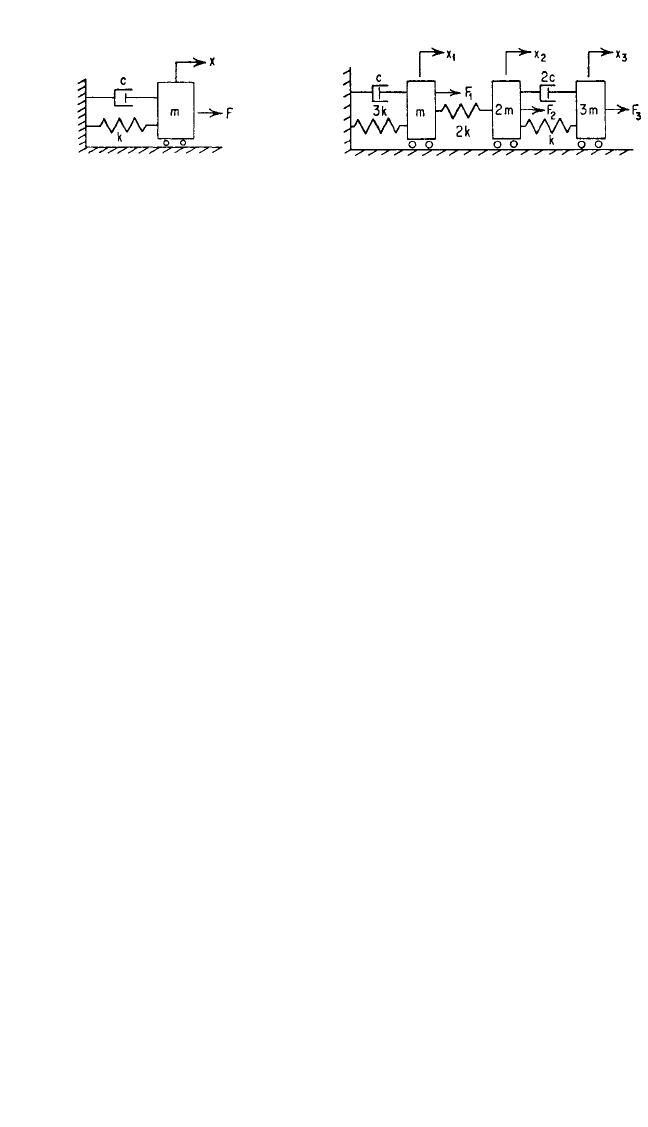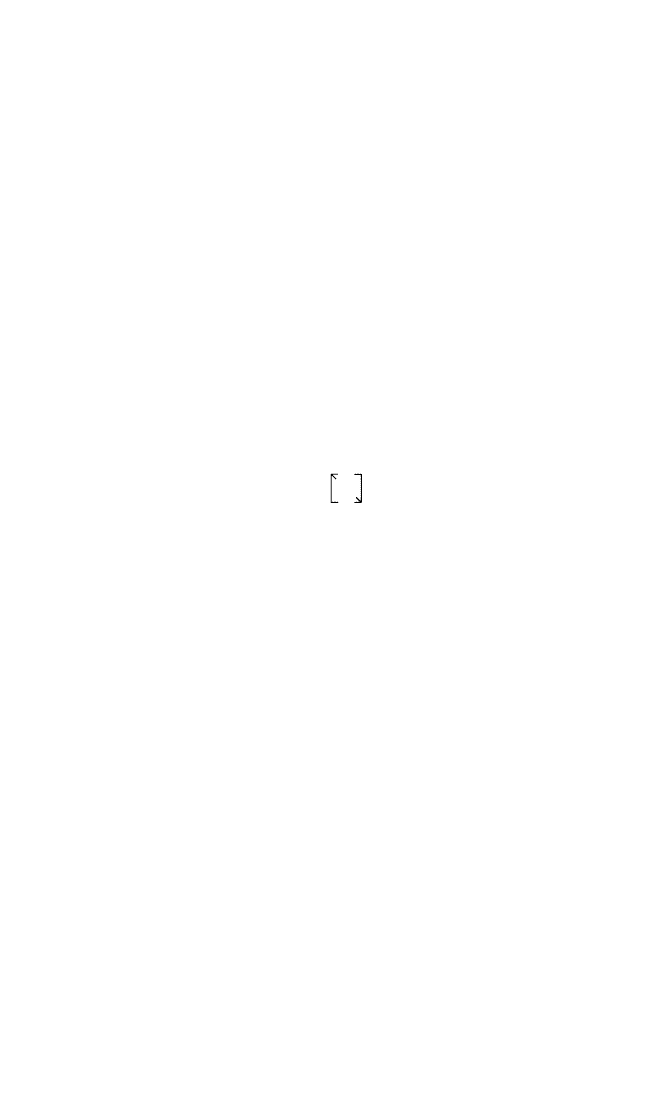Harris C.M., Piersol A.G. Harris Shock and vibration handbook
Подождите немного. Документ загружается.


mary difference is in the fact that the test-specified reference-response vector, {r(t)},
consists of waveforms that cannot be processed within a single FFT frame. For this
reason, like in the discussion about single-exciter waveform control methods, an
overlap-and-add technique
1
has to be used in both the time-to-frequency and
frequency-to-time transformations within the DVCS used for MIMO long-term
response waveform control.The issues that are associated with the use of the overlap-
and-add indirect convolution technique need to be considered and addressed.
1,30,32
Again, as in MIMO random, MIMO sine, and MIMO transient/shock applica-
tions, the MIMO system under test is driven with a vector of time-histories, {d(t)},
such that the control-response vector, {c(t)}, in this case a vector of time-histories,
agrees within an acceptable error margin with the test-specified reference-response
vector {r(t)}, which is also a vector of time-histories.
Modal Testing. Modal testing is conducted to excite a system under test, acquire
its drive and response signals, and estimate its frequency response characteristics to
determine experimentally the natural frequencies, mode shapes, and associated
damping factors of a structure via modal analysis. Modal analysis is discussed thor-
oughly in Chap. 21. Typically, much of the DVCS hardware and its shock and vibra-
tion data acquisition and analysis software is usable for this application.
Currently, digital computers are applied in modal testing in two distinct ways.
First, for sinusoidal excitation, computers are employed as an aid in obtaining the
desired purity of the modal excitation as well as in acquiring and processing data,
usually with operator adjustments of the frequency, the relative phase, and the
amplitude of several sine-wave outputs. These are used to drive a system under test
so as to achieve a particular relative phase and amplitude between chosen response
points on the system under test that is characteristic of a particular normal mode
response. The use of MIMO sine control methods can simplify this process. Second,
and more commonly, the DVCS is used to excite the system under test with either a
broad bandwidth random or a transient excitation, usually with several such outputs.
The response and drive signals are acquired and processed using FFT computations
with the methods discussed on frequency response function and frequency response
matrix estimation, using Eq. (27.4). The use of MIMO random control methods can
simplify this process. The frequency response functions are typically measured
between chosen response points on the system under test, while exciting the system
under test with the chosen excitation at prespecified excitation points, as discussed
previously and in Chap. 21. The frequency response functions and/or frequency
response matrices thus estimated are subsequently passed to modal analysis soft-
ware for further processing and extraction of the pertinent modal data using the
methods of Chap. 21.
REFERENCES
1. Oppenheim, A. V., and R. W. Schafer: “Digital Signal Processing,” Prentice-Hall, Inc.,
Englewood Cliffs, N.J., 1975.
2. Dennis, E., Jr., and R. B. Schnabel: “Numerical Methods in Optimization and Nonlinear
Equations,” Prentice-Hall, Inc., Englewood Cliffs, N.J., 1982.
3. Press, W. H., et al.: “Numerical Recipes in FORTRAN: The Art of Scientific Computing,”
2d ed., Cambridge University Press, Cambridge, England, 1992.
4. Norsworthy, S. R., R. Schreier, and G. C. Temes: “Delta-Sigma Data Converters: Theory,
Design, and Simulation,” The Institute of Electrical and Electronics Engineers, Inc., New
York, 1997.
27.34 CHAPTER TWENTY-SEVEN
8434_Harris_27_b.qxd 09/20/2001 11:51 AM Page 27.34

5. Stark, H., and F. B. Tuteur: “Modern Electrical Communications: Theory and Systems,”
Prentice-Hall, Inc., Englewood Cliffs, N.J., 1979.
6. Pilkey, W., K. Saczalski, and H. Schaeffer: “Structural Mechanics Computer Programs,
Surveys, Assessments and Availability,” University Press of Virginia, Charlottesville, Va.,
1974.
7. Pilkey, W., and B. Pilkey: “Shock Vibration Computer Programs Reviews and Summaries,”
SVM-10, Shock and Vibration Information Center, Washington, D.C., 1975.
8. Mei, C.: “Component Mode Synthesis and Large Deflection Vibration of Complex Struc-
tures,” NASA CR-181290, NASA CR-181291, NASA CR-1818292, National Aeronautics
and Space Administration, Washington, D.C., 1987.
9. Anon., “Development of a Probabilistic Component Mode Synthesis Method,” NAS 1 15
111870, National Aeronautics and Space Administration, Washington, D.C., 1997.
10. Brebbia, C. A., and S. Walker: “Boundary Element Techniques in Engineering,” Butter-
worth & Co. Ltd., London, England, 1980.
11. Brebbia, C. A., J. C. F. Telles, and L. C. Wrobel: “Boundary Element Techniques,” Springer-
Verlag, New York, 1984.
12. Fyfe, K. R., J.-P. G. Coyette, and P. A. van Vooren: Sound and Vibration, 25(12) (1991).
13. Lyon, R. H.:“Statistical Energy Analysis of Dynamical Systems: Theory and Applications,”
MIT Press, Cambridge, Mass., 1975.
14. Wilson, H. B., and S. Gupta: Sound and Vibration, 26(8):24 (1992).
15. Porter, M. L.: Personal Engineering & Instrumentation News, 10(3):29 (1993).
16. Himelblau, H.,A. G. Piersol, J. H. Wise, and M. R. Gundvig: “Handbook for Dynamic Data
Acquisition and Analysis,” RP-DTE 012.1, Institute of Environmental Sciences and Tech-
nologies, Mount Prospect, Ill., 1994.
17. Brillinger, D. R.:“Time Series: Data Analysis and Theory,” expanded ed., Holden-Day, Inc.,
San Francisco, Calif., 1981.
18. Hannan, E. J.: “Multiple Time Series,” John Wiley & Sons, Inc., New York, 1970.
19. Bendat, J. S., and A. G. Piersol:“Random Data:Analysis and Measurement Procedures,” 3d
ed., John Wiley & Sons, Inc., New York, 2000.
20. Dodds, C. J., and Robson, J. D.: J. Sound and Vibration, 42(2):243 (1975).
21. Bendat, J. S.: J. Sound and Vibration, 44(3):311 (1975).
22. Smallwood, D. O.: “Random Vibration Testing of a Single Test Item with a Multiple Input
Control System,” Proc. Institute of Environmental Sciences, p. 42, April 1982.
23. Pelletier, M. P., and Underwood, M. A.: “Multichannel Simultaneous Digital Tracking Fil-
ters for Swept Sine Vibration Control,” Proc. Institute of Environmental Sciences and Tech-
nology, Vol. 2, p. 338, April 1994.
24. Smallwood, D. O.: “Shock Testing on Shakers by Using Digital Control,” IES Technology
Monograph, Institute of Environmental Sciences, Mount Prospect, Ill., 1986.
25. Nelson, D. B.: “Parameter Specification for Shaker Shock Waveform Synthesis—Damped
Sines and Wavelets,” Proc., 60th Shock and Vibration Symposium,Vol. III, 1989.
26. Newland, D. E.: “Random Vibrations, Spectral and Wavelet Analysis,” 3d ed., Longman
Group Limited, Essex, England, 1993.
27. Underwood, M. A.: “Optimization of Classical Shock Waveforms,” Proc. Institute of Envi-
ronmental Sciences, p. 50,April 1982.
28. Scavuzzo, R. J., and H. C. Pusey: “Principles and Techniques of Shock Data Analysis,” 2d
ed., SVM-16, Shock and Vibration Information and Analysis Center, Arlington, Va., 1996.
29. Underwood, M. A.: “Applications of Optimal Control Concepts to Digital Shaker Control
Systems,” Proc. Institute of Environmental Sciences, p. 165, May 1981.
30. Keller, T., and M. A. Underwood: “An Application of MIMO Techniques to Satellite Test-
ing,” Proc. Institute of Environmental Sciences and Technology, April 2001.
APPLICATION OF DIGITAL COMPUTERS 27.35
8434_Harris_27_b.qxd 09/20/2001 11:51 AM Page 27.35

31. Sinn, L. A., and M. A. Underwood: “Considerations for the Design and Development of
Mixed-Mode Vibration Control Systems,” Proc. Institute of Environmental Sciences and
Technology, p. 296,April 1995.
32. Smallwood, D. O.: J. IEST, 60(5):27 (1996).
33. Hamma, G. A., R. C. Stroud, M.A. Underwood,W. B. Woyski, R. C.Taucher, and K. L. Cap-
pel: Sound and Vibration, 30(4):20 (1996).
34. Smallwood, D. O., and T. L. Paez:“A Frequency Domain Method for the Generation of Par-
tially Coherent Normal Stationary Time Domain Signals,” Shock and Vibration, 1(1):373
(1994).
35. Underwood, M. A.: “Adaptive Control Method for Multi-Exciter Sine Tests,” U.S. Patent
No. 5,299,454, April 1994.
27.36 CHAPTER TWENTY-SEVEN
8434_Harris_27_b.qxd 09/20/2001 11:51 AM Page 27.36

CHAPTER 28, PART I
MATRIX METHODS
OF ANALYSIS
Stephen H. Crandall
Robert B. McCalley, Jr.
INTRODUCTION
The mathematical language which is most convenient for analyzing multiple degree-
of-freedom vibratory systems is that of matrices. Matrix notation simplifies the pre-
liminary analytical study, and in situations where particular numerical answers are
required, matrices provide a standardized format for organizing the data and the
computations. Computations with matrices can be carried out by hand or by digital
computers. The availability of programs such as MATLAB makes the solution of
many complex problems in vibration analysis a matter of routine.
This chapter describes how matrices are used in vibration analysis. It begins with
definitions and rules for operating with matrices.The formulation of vibration prob-
lems in matrix notation then is treated. This is followed by general matrix solutions
of several important types of vibration problems, including free and forced vibra-
tions of both undamped and damped linear multiple degree-of-freedom systems.
Part II of this chapter considers finite element models.
MATRICES
Matrices are mathematical entities which facilitate the handling of simultaneous equa-
tions. They are applied to the differential equations of a vibratory system as follows:
A single degree-of-freedom system of the type in Fig. 28.1 has the differential
equation
m¨x + c˙x + kx = F
where m is the mass, c is the damping coefficient, k is the stiffness, F is the applied
force, x is the displacement coordinate, and dots denote time derivatives. In Fig. 28.2
a similar three degree-of-freedom system is shown.The equations of motion may be
obtained by applying Newton’s second law to each mass in turn:
m¨x
1
+ c˙x
1
+ 5kx
1
− 2kx
2
= F
1
2m¨x
2
+ 2c˙x
2
− 2c˙x
3
− 2kx
1
+ 3kx
2
− kx
3
= F
2
(28.1)
3mx¨
3
− 2c˙x
2
+ 2c˙x
3
− kx
2
+ kx
3
= F
3
28.1
8434_Harris_28_b.qxd 09/20/2001 11:48 AM Page 28.1

The accelerations, velocities, displacements, and forces may be organized into
columns, denoted by single boldface symbols:
¨x
1
˙x
1
x
1
F
1
¨x =
¨x
2
˙x =
˙x
2
x =
x
2
f =
F
2
(28.2)
¨x
3
˙x
3
x
3
F
3
The inertia, damping, and stiffness coefficients may be organized into square
arrays:
m 00 c 00 5k −2k 0
M =
02m 0
C =
02c −2c
K =
−2k 3k −k
(28.3)
00 3m 0 −2c 2c 0 −kk
By using these symbols, it is shown below that it is possible to represent the three
equations of Eq. (28.1) by the following single equation:
M¨x + C˙x + Kx = f (28.4)
Note that this has the same form as the differential equation for the single degree-of-
freedom system of Fig. 28.1. The notation of Eq. (28.4) has the advantage that in sys-
tems of many degrees-of-freedom it clearly states the physical principle that at every
coordinate the external force is the sum of the inertia, damping, and stiffness forces.
Equation (28.4) is an abbreviation for Eq. (28.1). It is necessary to develop the rules
of operation with symbols such as those in Eqs. (28.2) and (28.3) to ensure that no
ambiguity is involved.The algebra of matrices is devised to facilitate manipulations of
simultaneous equations such as Eq. (28.1). Matrix algebra does not in any way sim-
plify individual operations such as multiplication or addition of numbers, but it is an
organizational tool which permits one to keep track of a complicated sequence of
operations in an optimum manner. Matrices are essential elements of linear algebra,
1
and are widely employed in structural analysis
2
and vibration analysis.
3
DEFINITIONS
A matrix is an array of elements arranged systematically in rows and columns. For
example, a rectangular matrix A, of elements a
jk
, which has m rows and n columns is
a
11
a
12
...a
1n
A = [a
jk
] =
a
21
a
22
... a
2n
... ... ... ...
a
m1
a
m2
... a
mn
28.2 CHAPTER TWENTY-EIGHT, PART I
FIGURE 28.1 Single degree-of-freedom sys-
tem.
FIGURE 28.2 Three degree-of-freedom sys-
tem.
8434_Harris_28_b.qxd 09/20/2001 11:48 AM Page 28.2

The elements a
jk
are usually numbers or functions, but, in principle, they may be any
well-defined quantities.The first subscript j on the element refers to the row number
while the second subscript k refers to the column number. The array is denoted by
the single symbol A, which can be used as such during operational manipulations in
which it is not necessary to specify continually all the elements a
jk
. When a numeri-
cal calculation is finally required, it is necessary to refer back to the explicit specifi-
cations of the elements a
jk
.
A rectangular matrix with m rows and n columns is said to be of order (m,n). A
matrix of order (n,n) is a square matrix and is said to be simply a square matrix of
order n. A matrix of order (n,1) is a column matrix and is said to be simply a column
matrix of order n. A column matrix is sometimes referred to as a column vector. Simi-
larly, a matrix of order (1,n) is a row matrix or a row vector. Boldface capital letters are
used here to represent square matrices and lower-case boldface letters to represent
column matrices or vectors. For example, the matrices in Eq. (28.2) are column matri-
ces of order three and the matrices in Eq. (28.3) are square matrices of order three.
Some special types of matrices are:
1. A diagonal matrix is a square matrix A whose elements a
jk
are zero when j ≠ k.
The only nonzero elements are those on the main diagonal, where j = k. In order to
emphasize that a matrix is diagonal, it is often written with small ticks in the direc-
tion of the main diagonal:
A = a
jj
2. A unit matrix or identity matrix is a diagonal matrix whose main diagonal elements
are each equal to unity. The symbol I is used to denote a unit matrix. Examples are
100
1 0
0 1 0
01
001
3. A null matrix or zero matrix has all its elements equal to zero and is simply
written as zero.
4. The transpose A
T
of a matrix A is a matrix having the same elements but with
rows and columns interchanged. Thus, if the original matrix is
A = [a
jk
]
the transpose matrix is
A
T
= [a
jk
]
T
= [a
kj
]
For example:
32 3−1
A =
−14
A
T
=
24
The transpose of a square matrix may be visualized as the matrix obtained by rotat-
ing the given matrix about its main diagonal as an axis.
The transpose of a column matrix is a row matrix. For example,
3
x =
−4
x
T
= [3 4 −2]
−2
MATRIX METHODS OF ANALYSIS 28.3
8434_Harris_28_b.qxd 09/20/2001 11:48 AM Page 28.3

Throughout this chapter a row matrix is referred to as the transpose of the corre-
sponding column matrix.
5. A symmetric matrix is a square matrix whose off-diagonal elements are sym-
metric with respect to the main diagonal. A square matrix A is symmetric if, for all j
and k,
a
jk
= a
kj
A symmetric matrix is equal to its transpose. For example, all three of the matrices
in Eq. (28.3) are symmetric. In addition, the matrix M is a diagonal matrix.
MATRIX OPERATIONS
Equality of Matrices. Two matrices of the same order are equal if their corre-
sponding elements are equal. Thus two matrices A and B are equal if, for every j
and k,
a
jk
= b
jk
Matrix Addition and Subtraction. Addition or subtraction of matrices of the
same order is performed by adding or subtracting corresponding elements. Thus,
A + B = C if for every j and k,
a
jk
+ b
jk
= c
jk
For example, if
32 −1 2
A =
−14
B =
56
then
24 4 0
A + B =
4 10
A − B =
−6 −2
Multiplication of a Matrix by a Scalar. Multiplication of a matrix by a scalar c
multiplies each element of the matrix by c. Thus
cA = c[a
jk
] = [ca
jk
]
In particular, the negative of a matrix has the sign of every element changed.
Matrix Multiplication. If A is a matrix of order (m,n) and B is a matrix of order
(n,p), then their matrix product AB = C is defined to be a matrix C of order (m,p)
where, for every j and k,
c
jk
=
n
r = 1
a
jr
b
rk
(28.5)
The product of two matrices can be obtained only if they are conformable, i.e., if the
number of columns in A is equal to the number of rows in B.The symbolic equation
(m,n) × (n,p) = (m,p)
28.4 CHAPTER TWENTY-EIGHT, PART I
8434_Harris_28_b.qxd 09/20/2001 11:48 AM Page 28.4

indicates the orders of the matrices involved in a matrix product. Matrix products
are not commutative, i.e., in general,
AB ≠ BA
The matrix products which appear in this chapter are of the following types:
Square matrix × square matrix = square matrix
Square matrix × column vector = column vector
Row vector × square matrix = row vector
Row vector × column vector = scalar
Column vector × row vector = square matrix
In all cases, the matrices must be conformable. Numerical examples are given below.
AB =
=
−(3 × 1) + (2 × 5) (3 × 2) + (2 × 6)
=
(1 × 1) + (4 × 5) −(1 × 2) + (4 × 6)
(3 × 5) + (2 × 3)
Ax =
=
−(1 × 5) + (4 × 3)
=
32
y
T
A = [−21]
−14
= [−(2 × 3) − (1 × 1) − (2 × 2) + (1 × 4)] = [−70]
y
T
x = [−2 1]
= (−10 + 3) =−7
−(5 × 2) (5 × 1)
xy
T
=
[−2 1] =
−(3 × 2) (3 × 1)
=
The last product always results in a matrix with proportional rows and columns.
The operation of matrix multiplication is particularly suited for representing sys-
tems of simultaneous linear equations in a compact form in which the coefficients
are gathered into square matrices and the unknowns are placed in column matrices.
For example, it is the operation of matrix multiplication which gives unambiguous
meaning to the matrix abbreviation in Eq. (28.4) for the three simultaneous differ-
ential equations of Eq. (28.1). The two sides of Eq. (28.4) are column matrices of
order three whose corresponding elements must be equal. On the right, these ele-
ments are simply the external forces at the three masses. On the left, Eq. (28.4) states
that the resulting column is the sum of three column matrices, each of which results
from the matrix multiplication of a square matrix of coefficients defined in Eq.
(28.3) into a column matrix defined in Eq. (28.2). The rules of matrix operation just
given ensure that Eq. (28.4) is exactly equivalent to Eq. (28.1).
Premultiplication or postmultiplication of a square matrix by the identity matrix
leaves the original matrix unchanged; i.e.,
IA = AI = A
Two symmetrical matrices multiplied together are generally not symmetric. The
product of a matrix and its transpose is symmetric.
5
3
−10
−6
5
3
5
3
21
7
5
3
2
4
3
−1
18
22
7
21
2
6
−1
5
2
4
3
−1
MATRIX METHODS OF ANALYSIS 28.5
8434_Harris_28_b.qxd 09/20/2001 11:48 AM Page 28.5

Continued matrix products such as ABC are defined, provided the number of
columns in each matrix is the same as the number of rows in the matrix immediately
following it. From the definition of matrix products, it follows that the associative law
holds for continued products:
(AB)C = A(BC)
A square matrix A multiplied by itself yields a square matrix which is called the
square of the matrix A and is denoted by A
2
. If A
2
is in turn multiplied by A, the
resulting matrix is A
3
= A(A
2
) = A
2
(A). Extension of this process gives meaning to
A
m
for any positive integer power m. Powers of symmetric matrices are themselves
symmetric.
The rule for transposition of matrix products is
(AB)
T
= B
T
A
T
Inverse or Reciprocal Matrix. If, for a given square matrix A, a square matrix
A
−1
can be found such that
A
−1
A = AA
−1
= I (28.6)
then A
−1
is called the inverse or reciprocal of A. Not every square matrix A possesses
an inverse. If the determinant constructed from the elements of a square matrix is
zero, the matrix is said to be singular and there is no inverse. Every nonsingular
matrix possesses a unique inverse. The inverse of a symmetric matrix is symmetric.
The rule for the inverse of a matrix product is
(AB)
−1
= (B
−1
)(A
−1
)
The solution to the set of simultaneous equations
Ax = c
where x is the unknown vector and c is a known input vector can be indicated with
the aid of the inverse of A. The formal solution for x proceeds as follows:
A
−1
Ax = A
−1
c
Ix = x = A
−1
c
When the inverse A
−1
is known, the solution vector x is obtained by a simple matrix
multiplication of A
−1
into the input vector c.
Calculation of inverses and the solutions of simultaneous linear equations are
readily performed for surprisingly large values of n by programs such as MATLAB.
When n = 2 and
A =
x =
c =
hand-computation is possible using the following formulas:
A
−1
=
x
1
= x
2
=
∆
2
∆
∆
1
∆
−a
12
a
11
a
22
−a
21
1
∆
c
1
c
2
x
1
x
2
a
12
a
22
a
11
a
21
28.6 CHAPTER TWENTY-EIGHT, PART I
8434_Harris_28_b.qxd 09/20/2001 11:48 AM Page 28.6

where the determinants have the values
∆=a
11
a
22
− a
12
a
21
∆
1
= c
1
a
22
− c
2
a
12
∆
2
= c
2
a
11
− c
1
a
21
QUADRATIC FORMS
A general quadratic form Q of order n may be written as
Q =
n
j = 1
n
k = 1
a
jk
x
j
x
k
where the a
jk
are constants and the x
j
are the n variables. The form is quadratic since
it is of the second degree in the variables.The laws of matrix multiplication permit Q
to be written as
a
11
a
12
... a
1n
x
1
Q = [x
1
x
2
...x
n
]
a
21
a
22
... a
2n
x
2
... ... ... ... ...
a
n1
a
n2
... a
nn
x
n
which is
Q = x
T
Ax
Any quadratic form can be expressed in terms of a symmetric matrix. If the given
matrix A is not symmetric, it can be replaced by the symmetric matrix
B =
1
⁄2(A + A
T
)
without changing the value of the form.
As an example of a quadratic form, the potential energy V for the system of Fig.
28.2 is given by
2V = 3kx
1
2
+ 2k(x
2
− x
1
)
2
+ k(x
3
− x
2
)
2
= 5kx
1
x
1
− 2kx
1
x
2
− 2kx
2
x
1
+ 3kx
2
x
2
− kx
2
x
3
− kx
3
x
2
+ kx
3
x
3
Using the displacement vector x defined in Eq. (28.2) and the stiffness matrix K in
Eq. (28.3), the potential energy may be written as
V =
1
⁄2x
T
Kx
Similarly, the kinetic energy T is given by
2T = m˙x
1
2
+ 2m˙x
2
2
+ 3m˙x
3
2
In terms of the inertia matrix M and the velocity vector ˙x defined in Eqs. (28.3) and
(28.2), the kinetic energy may be written as
T =
1
⁄2 ˙x
T
M˙x
The dissipation function D for the system is given by
MATRIX METHODS OF ANALYSIS 28.7
8434_Harris_28_b.qxd 09/20/2001 11:48 AM Page 28.7
